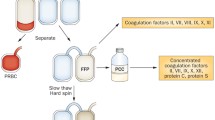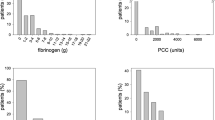Abstract
Objective
Since antithrombin III (AT III) substitution to normal activities could not be shown to have major beneficial effects in patients with end-stage chronic liver disease in a variety of clinical settings, we tested the hypothesis that substitution to supranormal activities decreases systemic procoagulant turnover better in this patient group.
Design
Controlled prospective clinical study.
Setting
Operating rooms at a University Hospital.
Patients
Twenty-four patients with histologically verified liver cirrhosis consecutively scheduled for liver transplantation.
Interventions
Nineteen patients were given an antithrombin III concentrate to achieve either 100 % (n=10) or 175 % (n=9) AT III activity. Control patients (n=5) received saline 0.9 % instead.
Measurements and results
Molecular markers of coagulation activation, platelet count and aggregability, and global coagulation variables were measured prior to AT III infusion and 60 min thereafter. In both AT Illtreated groups throm binantithrombin Illcomplex increased significantly (p<0.005), whereas prothrombin fragment Fl + 2, soluble fibrin and D-dimer concentrations, as well as other variables, did not show major char ges.
Conclusions
Despite thrombin in hibition by AT III in patients wit end-stage chronic liver disease, systemic procoagulant turnover was not significantly decreased 60 min after AT III application even to supranormal activities. Replenishment of the inhibitory antithrombin III pool, decreased in chronic liver disease, should not be expected to slow down the baseline con sumptive component of the haemostatic disorder in this patient group.
Similar content being viewed by others
References
Hallen A, Nilsson IM (1964) Coagulation studies in liver disease. Thrombosis et Diathesis Haemorrhagica 11: 51–63
Lechner K, Niessner H, Thaler E (1977) Coagulation abnormalities in patients with liver disease. Semin Thromb Hemost 4: 40–56
Knot EAR, Ten Cate JW, Drijfhout HR, Kahlé LH, Tytgat GN (1984) Antithrombin III metabolism in patients with liver disease. J Clin Pathol 37:523–530
Tytgat GN, Collen D, Verstraete M (1971) Metabolism of fibrinogen in cirrhosis of the liver. J Clin Invest 50: 1690–1701
Verstraete M, Vermiljen J, Collen D (1974) Intravascular coagulation in liver disease. Annu Rev Med 25: 447–455
Collen D, Rouvier J, Chamone DAF, Verstraete M (1978) Turnover of radiolabelled plasminogen and prothrombin in cirrhosis of the liver. Eur J Clin Invest 8:185–195
Schipper HG, Jenkins CS, Kahlé LH, Ten Cate JW (1978) Antithrombin III transfusion in disseminated intravascular coagulation. Lancet 1: 854–856
Schipper HG, Ten Cate JW (1982) Antithrombin III transfusion in patients with hepatic cirrhosis. Br J Haematol 52: 25–33
Langley PG, Hughes RD, Forbes A, Keays R, Williams R (1993) Controlled trial of antithrombin III supplementation in fulminant hepatic failure. J Hepatol 17:326–331
Palareti G, Legnani C, Maccaferri M, Gozzetti G, Mazziotti A, Martinelli G, Zanello M, Sama C, Coccheri S (1991) Coagulation and fibrinolysis in orthotopic liver transplantation: role of recipient’s disease and use of antithrombin III. Haemostasis 21: 68–76
Baudo F, De Gasperi A, De Cataldo F, Caimi TM, Cattaneo D, Redaelli R, Pannaciulli E, Corti A, Mazza E, Belli L (1992) Antithrombin III supplementation during orthotopic liver transplantation in cirrhotic patients: a randomized trial. Thromb Res 68: 409–416
Büller HR, Ten Cate JW (1983) Antithrombin III infusion in patients undergoing peritoneovenous shunt operation: failure in the prevention of disseminated intravascular coagulation. Thromb Haemostas 49:128–131
Shimada M, Matsumata T, Kamakura T, Hayashi H, Urata K, Sugimachi K (1994) Modulation of coagulation and fibrinolysis in hepatic resection: a randomized prospective control study using antithrombin III concentrates. Thromb Res 74:105–114
Müller-Berghaus G (1989) Pathophysiology and biochemical events in disseminated intravascular coagulation: dysregulation of procoagulant and anticoagulant pathways. Semin Thromb Hemost 15: 58–87
Himmelreich G, Riess H (1993) Pathophysiologie und Therapie der Verbrauchskoagulopathie. Klin Lab 39: 25–30
Scherer R, Gödde S, Giebler R, Schmutzler M, Erhard J, Kox WJ (1993) Recovery of antithrombin III in patients undergoing orthotopic liver transplantation after application of an AT III concentrate. Semin Thromb Hemost 19: 309–310
Ingerman-Wojenski CM, Silver MJ (1984) A quick method for screening platelet dysfunctions using the whole blood lumiaggregometer. Thromb Haemostas 51:154–156
Coleman M, Finlayson N, Bettigole RE, Saduba D, Cohn M, Pasmantier M (1975) Fibrinogen survival in cirrhosis improvement by low dose heparin. Ann Intern Med 83: 79–81
Ronneberger H, Hein B (1984) Wirkungen von Antithrombin III auf experimentelle Intoxikationen mit Hepatotoxinen bei Hunden. Arzneimittelforschung 34: 277–279
Fujiwara K, Ogata I, Ohta Y, Hirata K, Oka Y, Yamada S, Sato Y, Masaki N, Oka H (1988) Intravascular coagulation in acute liver failure in rats and its treatment with antithrombin III. Gut 29: 1103–1108
Christophe JL, Rouget C, Roullier M, Guyot F, Kieffer Y, Costes Y, Bresson S, Mantion G, Grillet M, Barale F (1991) Use of AT III concentrate during liver transplantation. Transplant Proc 23:1942–1943
Lechner K, Kyrle PA (1995) Antithrombin III concentrates — are they clinically useful? Thromb Haemostas 73: 340–348
Marcum JA, Rosenberg RD (1984) Anticoagulantly active heparin-like molecules from vascular tissue. Biochemistry 23:1730–1737
Marcum JA, Rosenberg RD (1987) Anticoagulantly active heparan sulfate proteoglycan and the vascular endothelium. Semin Thromb Hemost 13: 464–474
Clouse LH, Comp PC (1986) The regulation of hemostasis: the protein C system. N Engl J Med 314:1298–1304
Walker FJ, Fay PJ (1992) Regulation of blood coagulation by the protein C system. FASEB J 6: 2561–2567
Author information
Authors and Affiliations
Corresponding author
Additional information
This study was supported by the Department of Anesthesiology and Intensive Care Medicine, and the Department of General Surgery, University Hospital Essen, Germany
Rights and permissions
About this article
Cite this article
Scherer, R., Kabatnik, M., Erhard, J. et al. The influence of antithrombin III (AT III) substitution to supranormal activities on systemic procoagulant turnover in patients with end-stage chronic liver disease. Intensive Care Med 23, 1150–1158 (1997). https://doi.org/10.1007/s001340050472
Received:
Accepted:
Issue Date:
DOI: https://doi.org/10.1007/s001340050472




